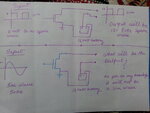Tahmid
Advanced Member level 6
- Joined
- Jun 17, 2008
- Messages
- 4,756
- Helped
- 1,798
- Reputation
- 3,588
- Reaction score
- 1,656
- Trophy points
- 1,413
- Location
- Berkeley, California
- Activity points
- 30,586
As long as flux density is within limits, you can transfer maximum power with 2 turns in primary and also with 4 turns in primary. The resistance of 2 turns or 4 turns is not enough to sufficiently restrict the current, so both can transfer maximum power.
But if you use 4 turns in primary, you're under-utilizing the core. So, you're winding more turns but not utilizing the core sufficiently. Even with 2 turns, the core is under-utilized. But with that, you're staying at safe levels. You might even be okay with 1 turn.
Hope this helps.
Tahmid.
But if you use 4 turns in primary, you're under-utilizing the core. So, you're winding more turns but not utilizing the core sufficiently. Even with 2 turns, the core is under-utilized. But with that, you're staying at safe levels. You might even be okay with 1 turn.
Hope this helps.
Tahmid.

